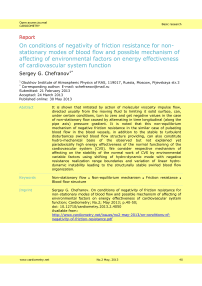On conditions of negativity of friction resistance for nonstationary modes of blood flow and possible mechanism of affecting of environmental factors on energy effectiveness of cardiovascular system function
Автор: Chefranov Sergey G.
Журнал: Cardiometry @cardiometry
Рубрика: Basic research
Статья в выпуске: 2, 2013 года.
Бесплатный доступ
It is shown that initiated by action of molecular viscosity impulse flow, directed usually from the moving fluid to limiting it solid surface, can, under certain conditions, turn to zero and get negative values in the case of non-stationary flow caused by alternating in time longitudinal (along the pipe axis) pressure gradient. It is noted that this non-equilibrium mechanism of negative friction resistance in the similar case of pulsating blood flow in the blood vessels, in addition to the stable to turbulent disturbances swirled blood flow structure providing, can also constitute hydro-mechanical basis of the observed but not explained yet paradoxically high energy effectiveness of the normal functioning of the cardiovascular system (CVS). We consider respective mechanism of affecting on the stability of the normal work of CVS by environmental variable factors using shifting of hydro-dynamic mode with negative resistance realization range boundaries and variation of linear hydrodynamic instability leading to the structurally stable swirled blood flow organization.
Blood flow structure, friction resistance, non-equilibrium, nonstationary flow
Короткий адрес: https://sciup.org/148308732
ID: 148308732
Список литературы On conditions of negativity of friction resistance for nonstationary modes of blood flow and possible mechanism of affecting of environmental factors on energy effectiveness of cardiovascular system function
- Karo K, Pedli T, Shroter R, Sid W. Blood circulation mechanics. Moscow: Mir; 1981.
- Regirer SA. Blood circulation hydro-dynamics. Moscow: Mir; 1971.
- Womersley JR. Oscillatory flow in arteries: the constrained elastic tube as a model of arterial flow and pulse transmission. Physics in Med. And Biol. 1957;2(2):178-187. PMCID:13484470
- Jonson P. Peripheral blood circulation. Moscow:Medicina; 1982.
- Landau LD, Lifshits YM. Hydrodynamics. Moscow: Nauka; 1986.
- Bargesyan MG. On coefficient of friction resistance for unsteady motion in pipes. Izv. AN Arm. SSR. 1971;24(6):10-14.
- Poedintsev, GM, Voronova, OK, Inventors. Method of defining the functional state of the heart left departments and adjoined with it large vessels. 1996. Committee of RF on patents and trade marks. Application for invention RU 94031904 A1 6A 61B 5/02 27.08.96.
- Rudenko MY, Voronova OK, Zernov VA, Mamberger KK, Makedonsky D, Rudenko SM. Theoretical principles of Cardiometry. Cardiometry.2012(1):7-23 DOI: 10.12710/cardiometry.2012.1.723
- Rudenko MY, Zernov VA, Voronova O.K. Fundamental Research on the Mechanism of Cardiovascular System Hemodynamics Self-Regulation and Determination of the norm-pathology boundary for the basic hemodynamic parameters and the analysis of the compensation mechanism as a method of revealing the underlying causes of the disease. Heart Rhythm. November 2012;9(11):1909-10.
- arXiv: 1112.0151v1[physics.flu-dyn]1Dec 2011
- Chefranov SG, Chefranov AG. New linear theory of hydrodynamic instability of the Hagen-Poiseuille flow and the blood swirling flows formation. Cardiometry. 2012(1):24-30 DOI: 10.12710/cardiometry.2012.1.2430
- Chefranov SG, Chefranov AG. Parametrical excitation of internal waves and convective instability in a fluid layer heated from above. Izvestia Akademii Nauk SSSR, Fizika Atmosphery i Okeana. 1983;19(7):741-749.
- Chefranov AS, Chefranov SG. Extrema of the Kinetic Energy and Its Dissipation Rate in Vortex Flows. Doklady Physics. 2003;48(12):696-700 DOI: 10.1134/1.1639440
- Chefranov SG, Chefranov AG, Rudenko MY, Zernov VA, Voronova OK. Оn the impact of atmosphere pressure variations on blood flow structural organization and energy efficiency of cardio-vascular system work. Int. Sci. Conf., Impact of Cosmic Weather on Health of Humans in Space and on the Earth; Moscow; 2012.
- Bockeria L, Kiknadze G, Gorodkov A, Gachechiladze I, Agafonov A. Application of tornado-flow fundamental hydrodynamic theory to the study of blood flow in the heart and main vessels-design of new implantable and accessory devices for cardiovascular surgery. ASME Int.Mech.End.Congress&Exposition IMECE, Houston, USA 2012.
- Rudenko MY, Zernov VA, Voronova O.K. Study of hemodynamic parameters using phase analysis of the cardiac cycle. Biomedical Engineering. November 2009;43(4):151-155 DOI: 10.1007/s10527-009-9121-9


